Transcribed from the Country Life issue of 23 December 1899, where it is one of the series, "Country Homes: Gardens Old & New" (see bibliography for details). The original illustrations are given as near as possible to their original position, lightened for clarity and sometimes slightly cropped. Page numbers are given in square brackets in the text. Please see also A Note on the Later Additions to Minley Manor. — Jacqueline Banerjee
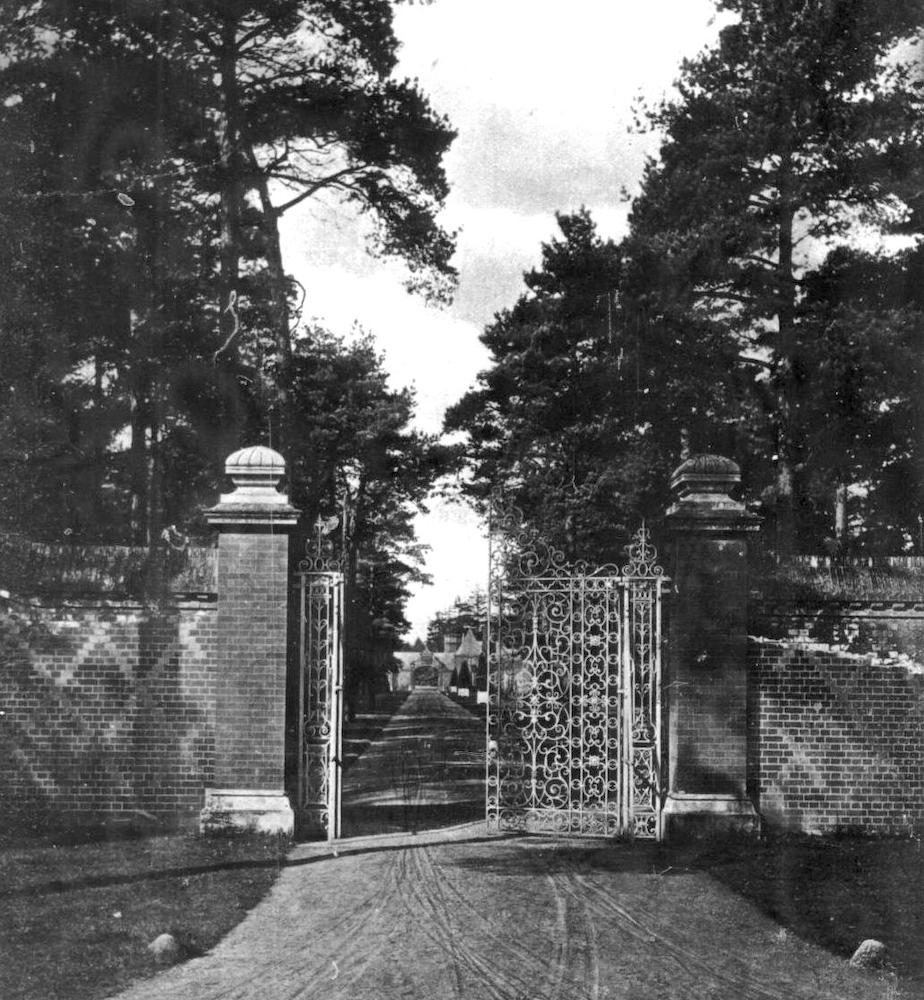
The Gates.
IT is an achievement of no small moment to create a great estate, or to give shape to the remains of one that is old. Minley Manor is among the most interesting of the comparatively modern estates in Hampshire. A great deal of labour and thought have been expended upon the place, and the highest architectural and gardening skill have been employed to endow it with the characters of imposing form and spacious aspect which it possesses. The magnificent gardens are necessarily formal, but are entirely appropriated to the mansion, and there is nothing oppressively stiff about them. They have the crowning merit of being extremely beautiful in the richness of tree and flower life.
The house is of red brick, with stone dressings, in the French Renaissance style with fine tourelles and steeply-pitched pyramidal roofs. The style is compounded out of the elements of the Gothic and later forms, and the house might have been transplanted from the banks of some river in Touraine. It has all the stateliness that belongs to the period of Francis I, if not all the characters of the style, and its lofty roofs and elaborate detail give dignity and charm to the aspect. There is always something attractive about a broken form of architecture; such a style has often been the forerunner of great changes in the state of society, and it was so conspicuously when the Gothic and Classic manners were combined in that form of architecture which we know as the Early Renaissance.
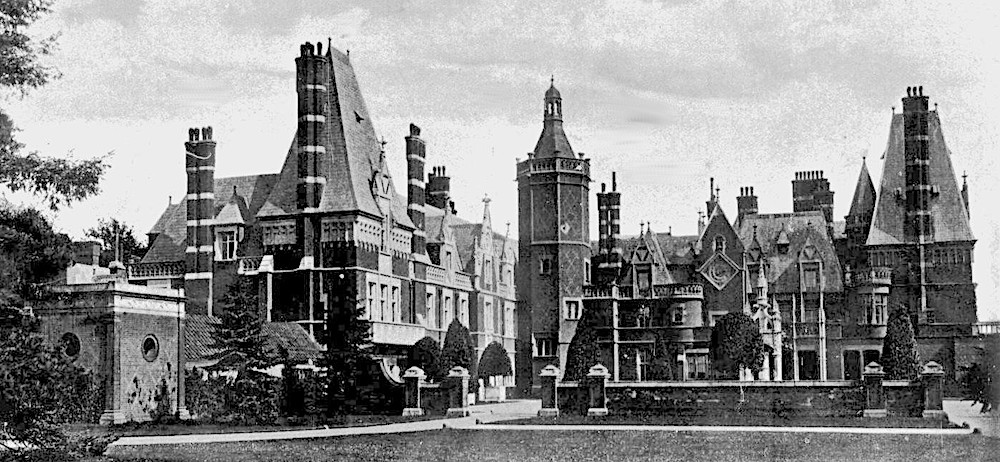
The Grand Entrance.
Upon Minley Manor every care has been bestowed. This may be discerned in the absolute completeness of the mansion and its surroundings. Nothing seems wanting in the artistic conception. For example, to give point and emphasis, as it were, to the garden, there are many exquisitely sculptured vases, and the statuary leaves little to be desired. Looking through the archway to the fruit gardens, with its festooning of ivy, we discover an unusual feature in an armillary sphere, which adds a quaintness and distinctive character that seem to belong to such places. But in short, look where we may, there is something either in the house or its surroundings that appeals with full satisfaction to the artistic-sense.
Minley stands near to Farnborough and Aldershot, in an excellent situation in that land of healthy hills. This borderland of Surrey and Hampshire has a character quite its own, and the mention of Bagshot sand will at once convey to the reader some idea of the configuration of the district, the nature of the soil, and the characteristics of its natural vegetation. He conjures up a vision of wide-stretching heaths, with undulating ground and low rounded hills, and plantations of Scotch pines which have so thrived that seedlings come up in all directions under the shelter of the heather and the gorse. The botanist knows what plants he is likely to find, while the gardener makes enquiries as to the depth from the surface of the iron "pan," and as to the difficulty [808/809] of breaking it up. The stranger is at once impressed by the stately beeches, trees which are not usually associated with such conditions as those indicated, but in this district they are plentiful, and their bronzed leaves in early winter contrast finely with the blue-green of the pines and the golden hue of the birches.

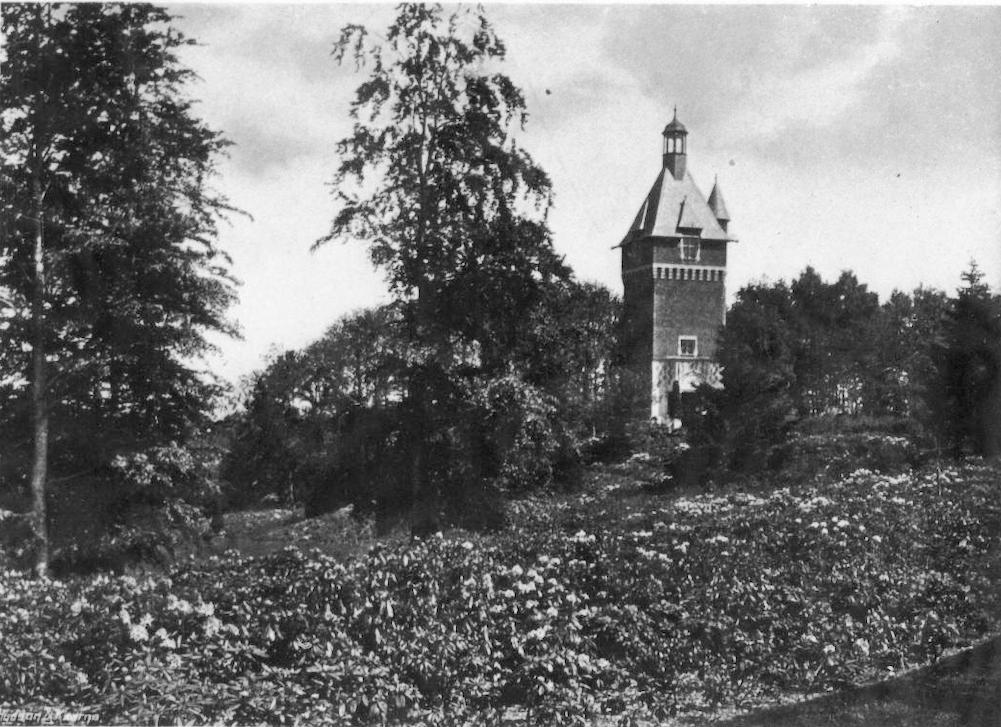
Left: The Formal Garden. Right: The Water Tower.
There is much to interest one in the manor and the gardens. The main entrance is through a courtyard, and looking from this into the grounds we see the long grass avenue, with its Wellingtonias, limes, and Douglas firs, the Wellingtonias and limes being, in alternate sequence, all down the line.
Passing through an archway to the courtyard, we enter a cloister, which seems to have been inspired by some reminiscence of Italy. From this point we have a glimpse of the "sunk winter garden." The form is a parallelogram, and the groundwork is formed of dark yews and edged with white Euonymus radicans. No fewer than 80,000 yews were used [809/810] when this garden was made, and their dark foliage serves to strengthen the effect of the scrolls and devices, which are worked out in gold and silver Retinosporas (R. plumosa aurea and R. squarrosa).
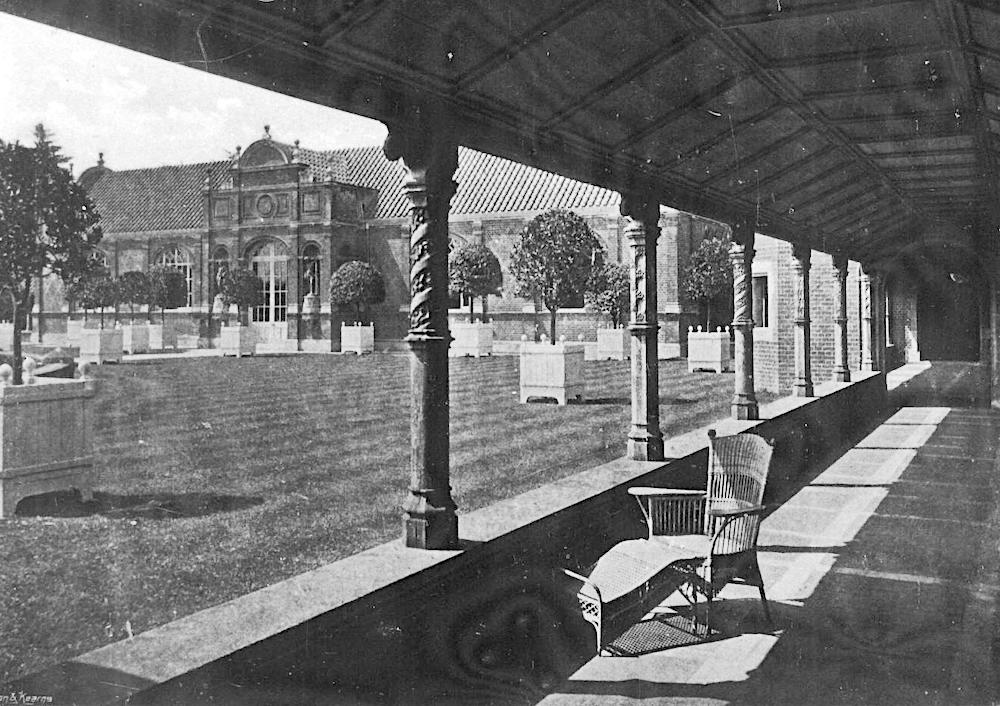
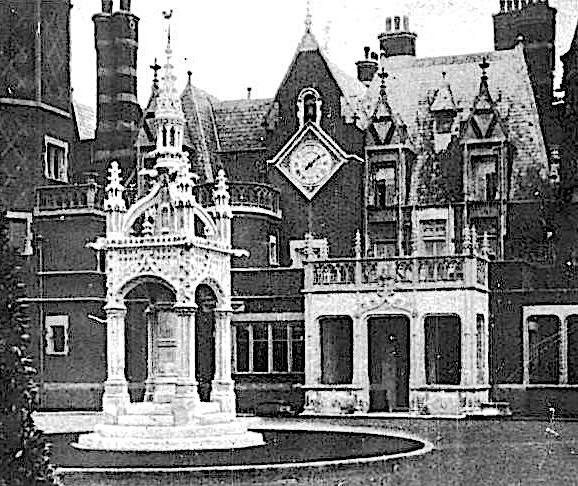
Left: The Cloisters. Right: The Entrance Court.
Other portions of the design represent the Currie coat of arms, and the monograms of Mr. and Mrs. Currie. Mound-like beds, arranged in panels of Golden Queen holly, alternating with Hodginsi holly, lend brightness, without glare, to the scene, even on the dullest winter day, whilst at night they are made to gleam in the rays of the electric light. These beds are constructed entirely of evergreen shrubs, so as to secure even a pleasant outlook in winter. This portion of the garden not in any sense apart from the house, but is really as it should be, so contrived to form with the terrace garden an integral part of the general scheme of architectural decoration.
Beyond the scroll garden, and joining it to the further woodland, we find a garden of bolder design. Here beds of hardy flowers are to be seen upon the grass, and it is only under suci: conditions that the rich beauty of hardy perennials is seen.
From the time of the daffodils to that of the starworts there is something in bloom to interest. Here too are the roses, the Berberis, B. Darwini and BB. stenophyila, rhododendrons, azaleas, golden-barbed willows,- and many other delightful things. There can be no monotony in such a garden as this, but a purposeful variety and a well-ordered system of arrangement.
Beyond this space, called "The Plain," we enter the glorious woods, with vistas of distant country seen through the trees. Douglas firs, pines, and many noble conifers give beauty to the landscape. The skilfully-constructed roads and banks are lined with heaths, Gaultherias, Berberis, etc., whilst to the grass [810/811] verges have been successfully transported large specimens of the more noble conifers. In the kitchen gardens we noticed fine pyramidal apple and pear trees upon broad grass verges, and it is very unusual to see quarters separated by holly, Retinospora, Osmanthus, and other low hedges. Seldom are these shrubs put to such a good use in kitchen gardens.
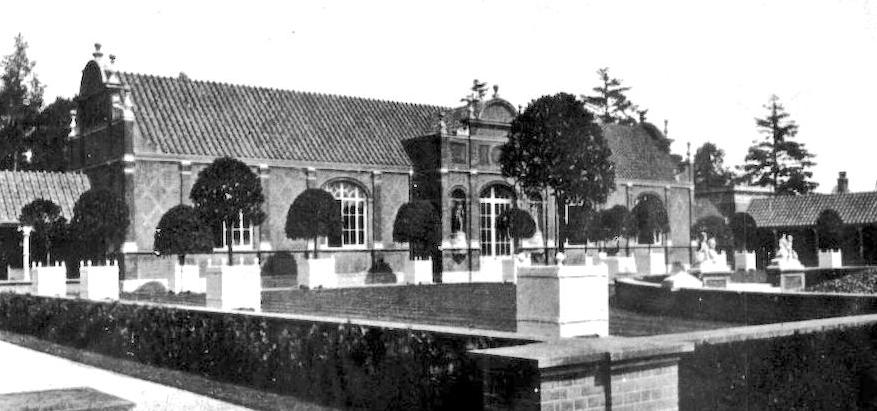

Left: The Orangery . Right: The Domestic Chapel.
It has been observed that the pleasure grounds of this house, though formal in their character, have yet nothing really stiff about them. Some of the older gardeners, and among them Sir Uvedale Price, held the view that, in proceeding from a house into the country through its grounds, there should be something of progressive rusticity. That which is formal near the structure would give place to more broken features as the house was left behind, and finally the departing guest would find himself in pleasure grounds disposed altogether in the landscape style. Something of this may be found at Minley Manor, for outside the region of the formal garden a beautiful country extends, ard we are led into it through glowing expanses, covered with rhododendrons and other flowering bushes, to tangled brakes pioneer of an altogether new sort of racing, at any rate as and woodlands, where the particular character of this borderland between Surrey and Hampshire exerts its power. The gardens of Minley Manor are attractive in winter owing to so many charming evergreen shrubs having been used. This is a feature of the gardener's art that should never' be overlooked, for nothing can be more disappointing than for the bright pleasures of summer to be replaced by dreary emptiness in the winter months. Mr. Currie is to be congratulated on possessing a fine estate and a noble house, well cared for, and with its garden and grounds full of variety and attraction, and in every respect appropriate to the mansion they adorn. Our pictures are, in fact, a liberal education in this special character of garden design.
Links to Related Material
- A Note on the Later Additions to Minley Manor by George Dewey and Arthur Castings
- Country Houses, New and Improved
- Styles in Domestic Architecture
Bibliography
"Minley Manor, Farnborough, Hants: The Seat of Mr. Laurence Currie." Country Life. 23 December 1899. Internet Archive. Web. 9 May 2024.
Created 9 May 2024